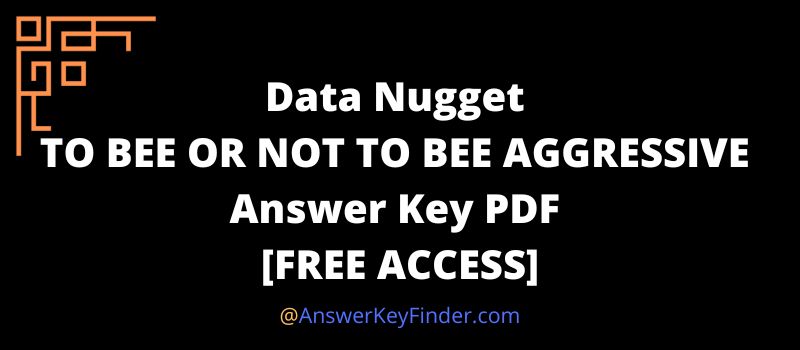In this session, we will be discussing about Data Nugget TO BEE OR NOT TO BEE AGGRESSIVE Answer Key PDF that is absolutely FREE to view.
NOTE: All answers for Data Nugget TO BEE OR NOT TO BEE AGGRESSIVE PDF are checked twice before publishing them to you. So, please do share as well if it helps.
Data Nugget TO BEE OR NOT TO BEE AGGRESSIVE Answers PDF
Find the free answers with PDF to Data Nugget TO BEE OR NOT TO BEE AGGRESSIVE topic questions below:
Note: In case, if you have anything to share related to this topic let us know through the comment box below.

>> Get PDF Here <<
>> Browse Other Data Nugget Answer Key Here <<
Data Nugget TO BEE OR NOT TO BEE AGGRESSIVE – Basic Terms
It’s good to learn a few basic definitions & answers so that it helps you to understand Data Nugget TO BEE OR NOT TO BEE AGGRESSIVE in deeper:
Q. Hypothesis
Ans: A hypothesis is an informed guess or proposed explanation made on the basis of limited evidence. It is used as a starting point for further investigation and research into a particular phenomenon and can be tested using scientific methods. Hypotheses are created based on observations and existing knowledge and then tested to see if they are correct or not.
Q. BEE (Hylaues, the masked bee)
Ans: several species of these bees are threatened with extinction in Hawaii; thanks to their baldness, they are often confused for wasps.
Q. BEE (Bombus, the bumblebee)
Ans: Dumbledore from the Harry Potter series is named after Bumblebees, because of J.K. Rowling’s image of him as ‘constantly humming’.
Q. Fly (Family: Bombyliidae)
Ans: this group of flies is called ‘bee flies’ because of their close resemblance to bees.
Q. BEE (Trigona, the vulture bee)
Ans: these tropical stingless bees are unique in that they eat rotting meat instead of pollen and nectar.
Q. Wasp (Family: Chrysididae)
Ans: This family is the cuckoo wasps! They lay their eggs in the nests of solitary bees so that their larvae can eat the food the bees bring home.
Q. BEE (Centris pallida, the digger bee)
Ans: This bee nests in the ground, in large aggregations of thousands of bees at a time. The males fight one another in big ‘bee balls’ to find mates.
Q. BEE (Osmia, the orchard bee)
Ans: Some species of orchard bees are used for commercial agriculture, just like the honeybee!
Q. BEE (Euglossa, the orchid bee)
Ans: These tropical bees come in rainbow, blue, green, purple, pink, red, and gold – and have long tongues to get nectar from orchids.
Q. BEE (Apis mellifera, the European honeybee)
Ans: The honeybee is not native to the Americas – instead, it was introduced from Europe.
Q. wasp (Family: Mutillidae, the cowkiller)
Ans: This wasp is wingless, earning it the name ‘velvet ant’, along with ‘cowkiller’ because of its highly painful sting.
Q. BEE (Augochlora, a sweat bee)
Ans: These bees are found in nearly every part of the United States (even your backyard!) and come in beautiful shades of green, blue, and gold.
Q. wasp – (Pepsis, the tarantula hawk)
Ans: The record holder for the most painful insect sting in the United States, these desert-dwelling wasps take down tarantulas to feed their young.
Q. ant queen (Family: Formicidae)
Ans: Ant queens start their lives with wings in order to leave their birth nest; the queen rips off her own wings when she digs to begin a new colony.
Q. hoverfly (Family: Syrphidae, the flower flies)
Ans: These flies are frequently seen buzzing around flowers, which (along with their yellow/black pattern) gets them confused for bees often.
Q. BEE (Xylocopa varipuncta male, the valley carpenter bee)
Ans: the males of this western US species are very fuzzy and orange, while the females are completely black.
Q. BEE (Rediviva longimanus, the South-African oil collecting bee)
Ans: This bee has specially evolved front legs that help it collect floral oils from its favorite, deep flowers!
Q. BEE (Coelioxys, sharp-tailed bees)
Ans: These are more cuckoos but bees, not wasps
Conclusion
TO BEE OR NOT TO BEE AGGRESSIVE is an interactive worksheet created by the Data Nuggets team.
Hope you find Data Nugget TO BEE OR NOT TO BEE AGGRESSIVE Answer Key PDF for free. Share with your batchmates/friends if you find it helpful.

Hi, I’m Thomas, and I’ve been a teacher for over 10 years and have taught students at all levels. I created this blog to really help students get ahead of their exams as well as provide helpful guides on various courses.

pls make this good
Any confusions to find the PDF ? Just click on “Get PDF Here” …. PDF will be available to download.
Hope that helped!